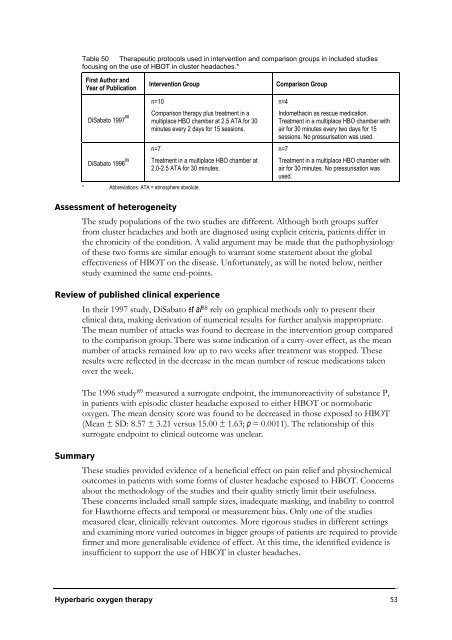Hyperbaric Oxygen Therapy - Hyperbaric Chamber Information ...
Hyperbaric Oxygen Therapy - Hyperbaric Chamber Information ...
Hyperbaric Oxygen Therapy - Hyperbaric Chamber Information ...
Create successful ePaper yourself
Turn your PDF publications into a flip-book with our unique Google optimized e-Paper software.
Table 50 Therapeutic protocols used in intervention and comparison groups in included studies<br />
focusing on the use of HBOT in cluster headaches.*<br />
First Author and<br />
Year of Publication<br />
DiSabato 1997 88<br />
DiSabato 1996 89<br />
* Abbreviations: ATA = atmosphere absolute.<br />
Intervention Group Comparison Group<br />
n=10<br />
Comparison therapy plus treatment in a<br />
multiplace HBO chamber at 2.5 ATA for 30<br />
minutes every 2 days for 15 sessions.<br />
n=7<br />
Treatment in a multiplace HBO chamber at<br />
2.0-2.5 ATA for 30 minutes.<br />
n=4<br />
Indomethacin as rescue medication.<br />
Treatment in a multiplace HBO chamber with<br />
air for 30 minutes every two days for 15<br />
sessions. No pressurisation was used.<br />
n=7<br />
Treatment in a multiplace HBO chamber with<br />
air for 30 minutes. No pressurisation was<br />
used.<br />
Assessment of heterogeneity<br />
The study populations of the two studies are different. Although both groups suffer<br />
from cluster headaches and both are diagnosed using explicit criteria, patients differ in<br />
the chronicity of the condition. A valid argument may be made that the pathophysiology<br />
of these two forms are similar enough to warrant some statement about the global<br />
effectiveness of HBOT on the disease. Unfortunately, as will be noted below, neither<br />
study examined the same end-points.<br />
Review of published clinical experience<br />
In their 1997 study, DiSabato et al88 rely on graphical methods only to present their<br />
clinical data, making derivation of numerical results for further analysis inappropriate.<br />
The mean number of attacks was found to decrease in the intervention group compared<br />
to the comparison group. There was some indication of a carry-over effect, as the mean<br />
number of attacks remained low up to two weeks after treatment was stopped. These<br />
results were reflected in the decrease in the mean number of rescue medications taken<br />
over the week.<br />
The 1996 study 89 measured a surrogate endpoint, the immunoreactivity of substance P,<br />
in patients with episodic cluster headache exposed to either HBOT or normobaric<br />
oxygen. The mean density score was found to be decreased in those exposed to HBOT<br />
(Mean ± SD: 8.57 ± 3.21 versus 15.00 ± 1.63; p = 0.0011). The relationship of this<br />
surrogate endpoint to clinical outcome was unclear.<br />
Summary<br />
These studies provided evidence of a beneficial effect on pain relief and physiochemical<br />
outcomes in patients with some forms of cluster headache exposed to HBOT. Concerns<br />
about the methodology of the studies and their quality strictly limit their usefulness.<br />
These concerns included small sample sizes, inadequate masking, and inability to control<br />
for Hawthorne effects and temporal or measurement bias. Only one of the studies<br />
measured clear, clinically relevant outcomes. More rigorous studies in different settings<br />
and examining more varied outcomes in bigger groups of patients are required to provide<br />
firmer and more generalisable evidence of effect. At this time, the identified evidence is<br />
insufficient to support the use of HBOT in cluster headaches.<br />
<strong>Hyperbaric</strong> oxygen therapy 53



